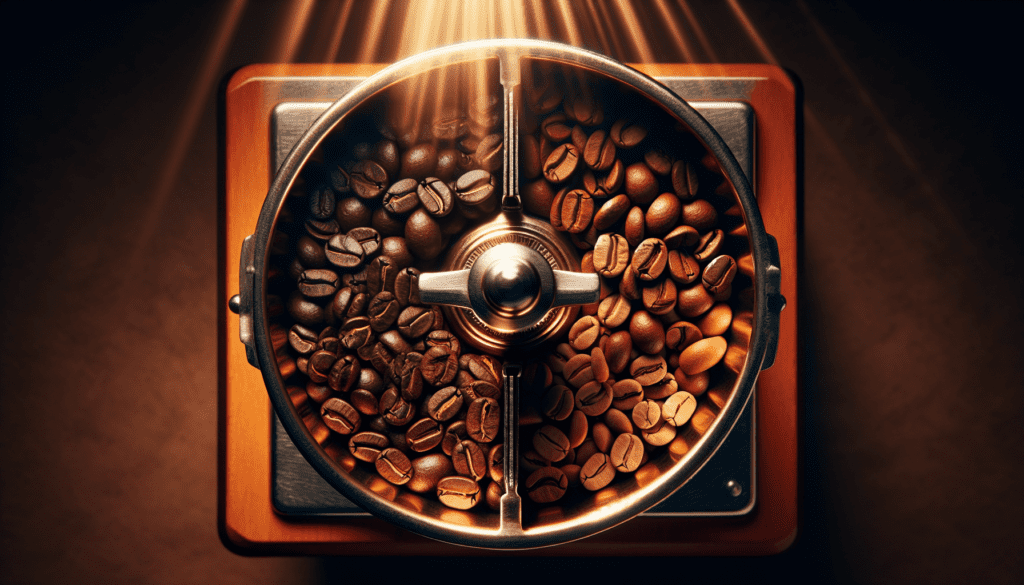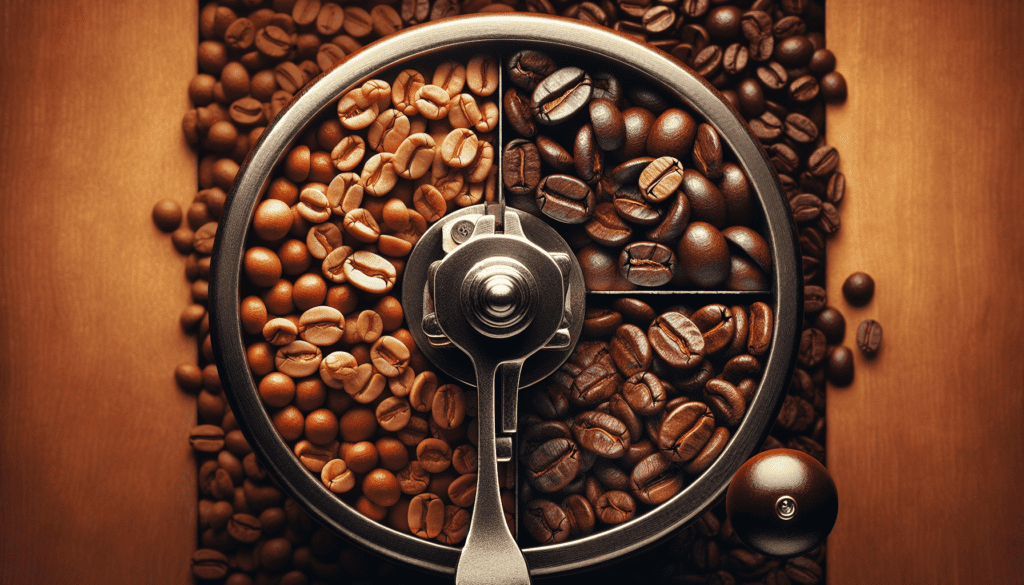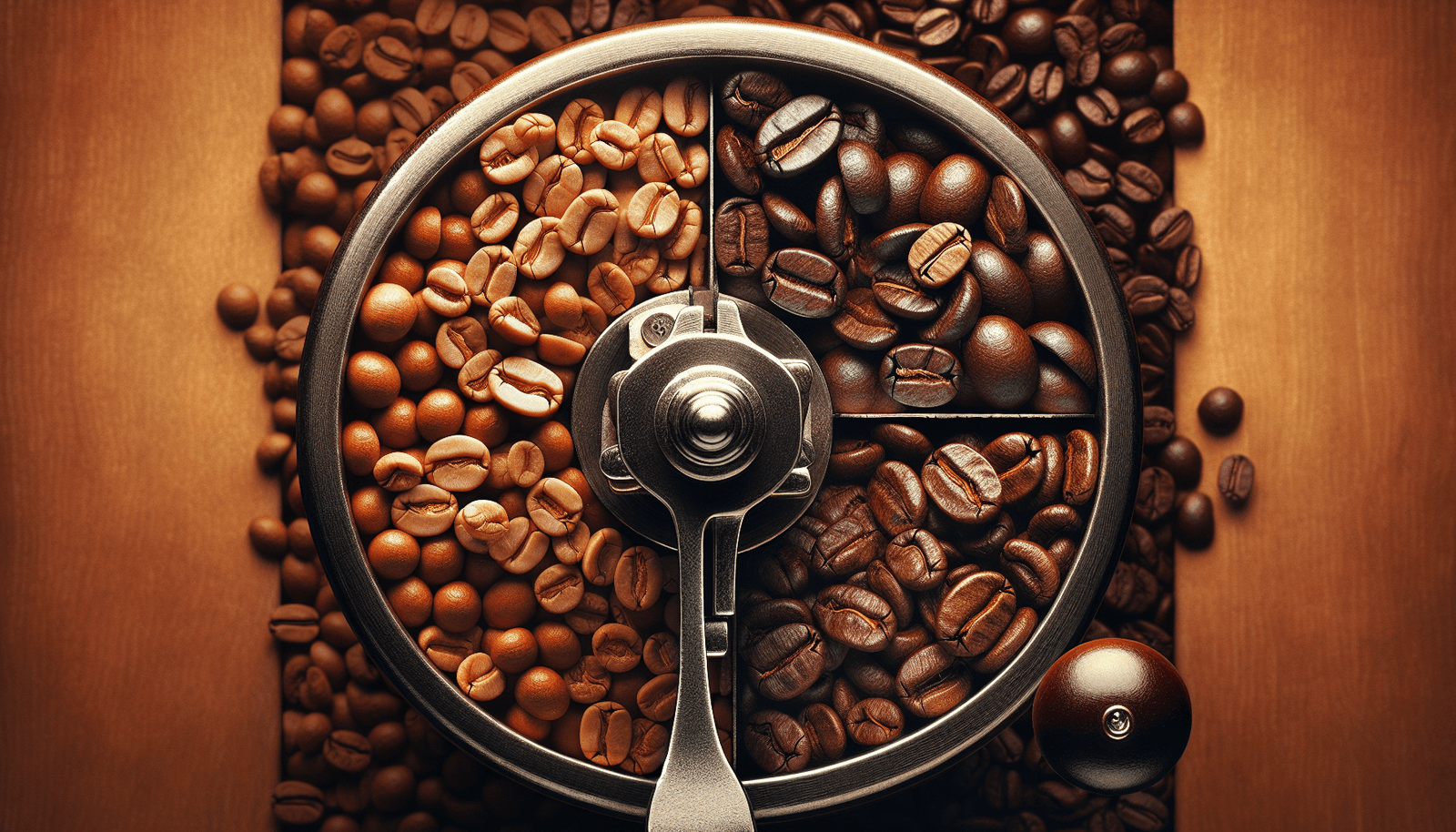Are you a coffee enthusiast who is intrigued by the world of coffee beans? If so, you’ve come to the right place! In this article, we will explore the fascinating differences between espresso beans and coffee beans. From their origins in various parts of the world to the best brewing methods for each type, we’ll cover it all. Whether you’re a newcomer seeking guidance or a seasoned coffee connoisseur looking to expand your knowledge, join us on this coffee journey as we uncover the nuances of these beloved beans. Get ready to dive into the world of flavors, aromas, and brewing techniques as we unravel the mystery of espresso beans and coffee beans.

Origin and Varieties
Coffee Beans: Wide Range of Origins
Coffee beans are cultivated and harvested in numerous countries around the world, each offering its own unique flavors and characteristics. Some of the most well-known coffee origins include Brazil, Colombia, Ethiopia, and Costa Rica. These different regions and climates play a significant role in determining the flavor profiles of the beans. For example, beans from Ethiopia often have fruity and floral notes, while those from Brazil tend to be nutty and chocolatey. Exploring the wide range of coffee bean origins allows you to discover new and exciting flavors that suit your palate.
Espresso Beans: Mostly Arabica Blend
When it comes to espresso beans, the majority of blends are made using Arabica beans. Arabica beans are known for their superior quality and complex flavors. These beans are grown at higher altitudes, which results in a slow maturation process and enhances the depth of flavor. While some espresso blends may also include Robusta beans, Arabica remains the preferred choice for its smoothness and less bitter taste. The blend of Arabica beans in espresso creates a harmonious and satisfying cup of coffee.
Roasting
Coffee Beans: Light to Dark Roasts
Coffee beans can be roasted to varying degrees, from light roasts to dark roasts. Light roasts are roasted for a shorter amount of time, preserving the original flavors of the beans. They tend to have a brighter acidity and more pronounced fruitiness. Medium roasts offer a balance between acidity and richness, with flavors becoming slightly more caramelized. Dark roasts, on the other hand, have a deep and smoky taste, with oils brought to the surface of the beans. The roast level you choose depends on your personal preference for acidity, body, and flavor intensity.
When it comes to espresso beans, they are typically roasted to dark levels. Dark roasting brings out the rich and intense flavors that are desired in espresso. The longer roasting time contributes to a more complex taste profile, with bold and smoky characteristics. The dark roast also helps to develop the oils within the beans, which is essential for creating the rich crema that sits atop a well-made espresso shot. The dark roast level of espresso beans ensures a strong and concentrated flavor that can stand up to milk in drinks like lattes and cappuccinos.
Grind Size
Coffee Beans: Varies Depending on Brew Method
The grind size of coffee beans is an important factor in determining the extraction and flavor of your brew. Different brew methods require different grind sizes to optimize the extraction process. For example, a coarse grind is suitable for methods like French press and cold brew, where the coffee is steeped for a longer time. On the other hand, a medium grind is ideal for drip coffee makers, while a fine grind is needed for pour-over methods. Adjusting the grind size allows you to control the extraction and achieve the desired flavor profile in your cup.
Espresso Beans: Fine, Consistent Grind
When it comes to grinding espresso beans, a fine and consistent grind is crucial. The finely ground coffee allows for a higher surface area and ensures a precise and controlled extraction. This is necessary to produce the intense and full-bodied flavor that is characteristic of espresso. The consistency of the grind is also important in ensuring even extraction and preventing the risk of channeling, where water flows through gaps in the coffee grounds rather than evenly extracting the flavors. Investing in a good quality espresso grinder is essential to achieve the perfect grind size for your espresso shots.
Flavor and Aroma
Coffee Beans: Varies Depending on Roast and Origin
The flavor and aroma of coffee beans can vary significantly, depending on the roast level and origin. Lighter roasts tend to preserve the natural flavors of the beans, offering bright acidity and vibrant fruity or floral notes. Medium roasts strike a balance between acidity and richness, with flavors that may include caramel or chocolate undertones. Dark roasts bring out the deep and smoky characteristics, with hints of dark chocolate or toasted nuts. Similarly, the origin of the beans plays a role in flavor variations. Different regions offer unique flavor profiles, from the citrusy notes of African coffees to the earthy tones of Central American beans.
Espresso Beans: Bold, Intense, and Rich
Espresso beans are specifically chosen and roasted to produce a bold, intense, and rich flavor profile. The dark roast level contributes to the deep and smoky taste that is desired in espresso shots. The concentrated flavor is achieved through the controlled extraction process, which pulls out the oils and soluble compounds from the finely ground beans. Espresso shots often exhibit a bittersweet taste, with notes of chocolate, caramel, or dark fruits. The rich and intense flavor of espresso beans allows them to shine in drinks like lattes and macchiatos, where they can hold their own against the addition of milk.

Caffeine Content
Coffee Beans: Varies Depending on Roast and Brew Method
The caffeine content in coffee beans can vary based on several factors, including the roast level and brew method. Lighter roasts generally have a higher caffeine content compared to darker roasts because the roasting process reduces caffeine levels. The brew method also affects caffeine extraction. Methods like espresso and Turkish coffee use a higher coffee-to-water ratio and shorter extraction time, resulting in a more concentrated caffeine content. On the other hand, brewing methods like pour-over and drip coffee may have a lower caffeine concentration due to their longer extraction times and larger water-to-coffee ratios.
Espresso Beans: Higher Caffeine Content per Volume
Espresso beans, being used for concentrated espresso shots, have a higher caffeine content per volume compared to regular coffee beans. This is because espresso shots use a higher coffee-to-water ratio and shorter extraction time, resulting in a more concentrated coffee beverage. Due to the finely ground beans and the pressurized brewing process, espresso shots contain a higher concentration of caffeine in a smaller serving size. This makes espresso a popular choice for those seeking a quick caffeine boost or a strong pick-me-up in a smaller quantity.
Use in Drinks
Coffee Beans: Brewed in Different Methods (Cold Brew, French Press, etc.)
Coffee beans have a versatile range of uses and can be brewed using various methods to suit individual preferences. Some popular brewing methods include drip brewing, pour-over, French press, Aeropress, and cold brew. Each method offers a unique flavor profile and characteristics, allowing you to explore different facets of the coffee beans. Drip brewing produces a well-rounded cup with balanced flavors, while a French press brings out the full-bodied richness. Pour-over emphasizes clarity and brightness, while cold brew extracts a smoother, low-acidity taste. With coffee beans, the possibilities are endless, and you can experiment to find your favorite brewing method.
Espresso Beans: Used Specifically for Espresso Shots
Espresso beans are specifically used to create espresso shots, which form the base of various espresso-based drinks. These beans are finely ground, allowing for a controlled and precise extraction process. The resulting espresso shot is a concentrated and intense coffee beverage that forms the foundation for drinks such as lattes, cappuccinos, and Americanos. The strong and bold flavors of espresso beans help to create the perfect balance and harmony when mixed with steamed milk or water. The use of espresso beans ensures a consistent and enjoyable coffee experience, especially for those who prefer the depth and intensity of espresso-based drinks.
Grind Freshness
Coffee Beans: Optimal to Grind Just Before Brewing
To achieve the best flavor and aroma from coffee beans, it is recommended to grind them just before brewing. Coffee beans contain volatile compounds that are responsible for the delightful scents and flavors we associate with coffee. When the beans are ground, these compounds are exposed to the air and begin to dissipate. By grinding the beans immediately before brewing, you can preserve the maximum freshness and capture the full range of flavors. Investing in a good quality burr grinder allows you to grind your coffee beans on-demand and ensures that each cup of coffee is a sensory delight.
Espresso Beans: Best When Ground Immediately Before Extraction
Similarly, espresso beans are best ground immediately before extraction to maintain freshness and optimize flavor. The finely ground beans used in espresso shots are highly susceptible to oxidation and flavor degradation. By grinding the beans just before extraction, you can ensure that the volatile aromas and flavors are captured at their peak. This allows for a more vibrant and flavorful espresso shot with a rich and full-bodied taste. For the best espresso experience, it is worthwhile to invest in a high-quality espresso grinder that can precisely grind the beans to the desired consistency.
Crema
Coffee Beans: Less Pronounced or Absent
Crema is the creamy, golden layer that sits on top of a well-made espresso shot. While crema is a defining characteristic of espresso, it is less pronounced or even absent when using regular coffee beans. Regular coffee beans, when brewed using methods like drip coffee or French press, do not undergo the pressurized extraction process that creates crema. This is because the crema is formed by the emulsification of coffee oils and CO2 gas during espresso extraction. If you enjoy the luscious layer of crema, using espresso beans specifically designed for this style of brewing is essential.
Espresso Beans: Produces Thick, Rich Crema Layer
Espresso beans are crafted to produce a thick and luscious layer of crema when extracted properly. The combination of the finely ground beans, the pressurized extraction process, and the oils released during brewing contribute to the formation of crema. The crema adds an extra element of visual appeal to espresso shots and acts as a protective layer, retaining heat and keeping the flavors locked in. A well-formed crema is an indication of a properly extracted espresso shot and adds to the overall sensory experience of drinking espresso.
Storage
Coffee Beans: Can Be Stored for Longer Periods
Coffee beans can be stored for longer periods compared to ground coffee, thanks to their state as whole beans. To ensure optimal freshness, it is best to store coffee beans in an airtight container, away from light, heat, and moisture. Whole beans have a lower surface area exposed to air, which helps to slow down the staling process. It is important to note that even when stored properly, coffee beans will gradually lose their freshness over time. Therefore, it is recommended to consume them within a few weeks of purchase for the best flavor experience.
Espresso Beans: Best to Use Freshly
Espresso beans, being used for a concentrated and intense brewing method, are best enjoyed when used freshly. Due to the finer grind size and the pressurized extraction process, espresso shots are more sensitive to staling than regular coffee. The volatile aromas and flavors in espresso beans tend to dissipate more quickly once the beans are exposed to air. To fully experience the richness and complexity of espresso, it is recommended to use freshly roasted espresso beans within a week of their roast date. This ensures that you capture the fullest flavors and aromas in each shot of espresso.
Price
Coffee Beans: Varies Depending on Quality and Origin
The price of coffee beans can vary widely based on factors such as the quality of the beans, the rarity of the origin, and the processing methods involved. Specialty grade coffee beans, which undergo a rigorous quality assessment, tend to command higher prices due to their superior flavor profiles and unique characteristics. Additionally, certain coffee origins that are renowned for their exceptional coffees, such as Jamaican Blue Mountain or Hawaiian Kona, may come at a higher price point. It is important to consider the value and the overall experience you desire when selecting coffee beans within your budget.
Espresso Beans: Often More Expensive
Espresso beans, particularly those of high quality, often come at a higher price compared to regular coffee beans. The additional cost can be attributed to various factors such as the specific selection and sourcing of beans, the complexity of the roasting process, and the attention to detail in producing espresso-specific flavors. Espresso beans are carefully crafted with a focus on delivering intense and satisfying flavor profiles, which requires meticulous sourcing, roasting, and blending. The premium quality and meticulous craftsmanship of espresso beans contribute to their higher price tag, reflecting the level of expertise and dedication required to produce exceptional espresso shots.
In summary, coffee beans and espresso beans have their own unique characteristics, flavors, and uses. Coffee beans offer a wide range of origins, roasting levels, and brewing methods, allowing for a diverse coffee experience. Espresso beans, on the other hand, are specifically chosen and roasted to create bold and concentrated espresso shots that serve as the base for various espresso-based drinks. Understanding the differences in origin, roasting, grind size, flavor, caffeine content, use in drinks, grind freshness, crema production, storage, and price between coffee beans and espresso beans can help you make informed choices and appreciate the nuances of each. So whether you prefer the versatility of coffee beans or the intensity of espresso beans, the world of caffeinated delights awaits your exploration. Cheers to a flavorful and enjoyable coffee journey!

